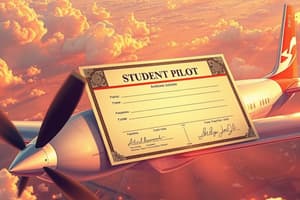Podcast
Questions and Answers
What is required for a student pilot before they can fly solo?
What is required for a student pilot before they can fly solo?
- An approval letter from the airport authority
- A medical certificate signed by a healthcare professional
- A flight plan filed with air traffic control
- A logbook endorsement from an authorized flight instructor (correct)
How frequently must a logbook endorsement be renewed for solo flight?
How frequently must a logbook endorsement be renewed for solo flight?
- Every 60 days
- Every 90 days (correct)
- Every time a flight is completed
- Every 30 days
In addition to a logbook endorsement, what other document is necessary for solo flight?
In addition to a logbook endorsement, what other document is necessary for solo flight?
- A government-issued photo identification (correct)
- A current insurance policy
- A notarized letter of consent from a guardian
- A training completion certificate
Who is authorized to endorse a student pilot's logbook for solo flight?
Who is authorized to endorse a student pilot's logbook for solo flight?
What specific aspect of the logbook endorsement is crucial for a student pilot's solo flight?
What specific aspect of the logbook endorsement is crucial for a student pilot's solo flight?
What does a HIWAS indicate on a navaid frequency?
What does a HIWAS indicate on a navaid frequency?
What is the frequency for Enroute Flight Advisory Service (EFAS)?
What is the frequency for Enroute Flight Advisory Service (EFAS)?
What actions should you take if you become lost while flying?
What actions should you take if you become lost while flying?
What are the minimum VFR fuel reserves required for daytime flight?
What are the minimum VFR fuel reserves required for daytime flight?
What should you do if weather deteriorates enroute?
What should you do if weather deteriorates enroute?
What frequency should you transmit on if unable to establish radio communications?
What frequency should you transmit on if unable to establish radio communications?
What are the minimum VFR fuel reserves required for night flight?
What are the minimum VFR fuel reserves required for night flight?
Where normally can you find the required documents needed for aircraft operation?
Where normally can you find the required documents needed for aircraft operation?
What is the MSL altitude for the traffic pattern at your airport?
What is the MSL altitude for the traffic pattern at your airport?
Describe the normal entry and exit procedures for the traffic pattern at your airport.
Describe the normal entry and exit procedures for the traffic pattern at your airport.
What are the recommended radio calls at an uncontrolled airport while in the traffic pattern?
What are the recommended radio calls at an uncontrolled airport while in the traffic pattern?
What is the standard direction of turns in a traffic pattern, and how is a nonstandard pattern indicated?
What is the standard direction of turns in a traffic pattern, and how is a nonstandard pattern indicated?
Explain the purpose of CTAF at uncontrolled airports.
Explain the purpose of CTAF at uncontrolled airports.
How can a pilot determine if a runway is closed?
How can a pilot determine if a runway is closed?
What should pilots include in their self-announce calls at an uncontrolled airport?
What should pilots include in their self-announce calls at an uncontrolled airport?
What are the typical procedures for using CTAF at your training airport?
What are the typical procedures for using CTAF at your training airport?
Does an alternator produce AC or DC current?
Does an alternator produce AC or DC current?
What are the basic advantages of an alternator over a generator?
What are the basic advantages of an alternator over a generator?
What is the purpose of the voltage regulator in an alternator system?
What is the purpose of the voltage regulator in an alternator system?
How can you detect alternator or generator failure in an aircraft?
How can you detect alternator or generator failure in an aircraft?
What is the function of an ammeter in an aircraft's electrical system?
What is the function of an ammeter in an aircraft's electrical system?
What should you do if a circuit breaker for an essential system trips?
What should you do if a circuit breaker for an essential system trips?
How does the use of a primer differ during cold and warm weather operations?
How does the use of a primer differ during cold and warm weather operations?
What action should you take if the oil pressure gauge does not indicate pressure after 30 seconds in cold weather?
What action should you take if the oil pressure gauge does not indicate pressure after 30 seconds in cold weather?
What is the computed density altitude given a field elevation of 5,000 ft, altimeter setting of 30.12 in.Hg, and outside air temperature of 35°C?
What is the computed density altitude given a field elevation of 5,000 ft, altimeter setting of 30.12 in.Hg, and outside air temperature of 35°C?
Based on a field elevation of 4,000 ft, outside air temperature of 29°C, and a headwind of 10 kts, how would you compute the takeoff distance for maximum weight?
Based on a field elevation of 4,000 ft, outside air temperature of 29°C, and a headwind of 10 kts, how would you compute the takeoff distance for maximum weight?
What is the expected landing distance on a field elevation of 3,000 ft with an outside air temperature of 10°C and a headwind of 10 kts for maximum landing weight?
What is the expected landing distance on a field elevation of 3,000 ft with an outside air temperature of 10°C and a headwind of 10 kts for maximum landing weight?
When climbing from sea level to a cruising altitude of 8,500 feet, what factors must be calculated for planning the climb?
When climbing from sea level to a cruising altitude of 8,500 feet, what factors must be calculated for planning the climb?
Describe the best technique for maximum braking effectiveness during a short-field landing.
Describe the best technique for maximum braking effectiveness during a short-field landing.
What differences can be expected in landing roll distance when landing on a sod runway compared to a paved runway?
What differences can be expected in landing roll distance when landing on a sod runway compared to a paved runway?
Define best angle-of-climb speed.
Define best angle-of-climb speed.
Define best rate-of-climb speed.
Define best rate-of-climb speed.
What transponder code should you squawk when declaring an emergency, unless instructed otherwise?
What transponder code should you squawk when declaring an emergency, unless instructed otherwise?
How can an intercepted aircraft communicate distress if unable to establish radio communication?
How can an intercepted aircraft communicate distress if unable to establish radio communication?
What are the major symptoms of hypoxia?
What are the major symptoms of hypoxia?
What corrective action should be taken in response to hypoxia?
What corrective action should be taken in response to hypoxia?
How does hyperventilation differ in symptoms from hypoxia?
How does hyperventilation differ in symptoms from hypoxia?
What should be done when a passenger shows symptoms that could be attributed to multiple conditions?
What should be done when a passenger shows symptoms that could be attributed to multiple conditions?
What are the effects of carbon monoxide poisoning on the body?
What are the effects of carbon monoxide poisoning on the body?
What are the general rules concerning alcohol use before operating an aircraft?
What are the general rules concerning alcohol use before operating an aircraft?
Flashcards are hidden until you start studying
Study Notes
Solo Flight Requirements
- A student pilot must have their pilot certificate and logbook endorsed by a certified flight instructor for the specific aircraft model they intend to fly solo.
- The logbook endorsement must be dated within 90 days of the student's solo flight.
- Students must also have a valid photo identification for solo flights.
Traffic Patterns
- Traffic patterns at uncontrolled airports require pilots to announce their position approximately 10 miles out and then call downwind, base, final, and clear of the runway after landing.
- Standard traffic patterns require all turns to the left unless indicated otherwise.
- Nonstandard patterns with right turns are indicated by an L-shaped extension on the segmented circle and are noted in airport publications.
- Pilots should announce their position and intentions using self-announcement calls on CTAF.
Radio Communications
- Two-way radio communications are required at controlled airports.
Runway Closure
- Closed runways and taxiways are marked with large "X"s.
In-Flight Weather Information
- HIWAS (Hazardous In-flight Weather Advisory Service) information can be accessed on the navaid frequency if marked on the sectional chart.
- EFAS (Enroute Flight Advisory Service) is available on 122.0 MHz.
- Automated weather information like AWOS or ATIS can be obtained from nearby airports.
Loss of Navigation
- If lost, prioritize becoming oriented by referencing landmarks and navigation instruments.
- Climb if necessary for better visibility and navaid reception.
- Communicate with ATC or FSS, and if unable to establish radio contact, transmit on 121.5 MHz.
Minimum VFR Fuel Reserves
- Minimum fuel reserves required by FARs are 30 minutes for day flights and 45 minutes for night flights.
Aircraft Certificates and Documents
- Required documents for aircraft operation include airworthiness certificate, registration certificate, operating limitations, and radio license.
Electrical System
- Aircraft electrical systems use alternators, generators, and voltage regulators.
- To detect alternator or generator failure, monitor the ammeter, warning light, and loadmeter for abnormal indications.
- The electrical system is protected by circuit breakers or fuses, depending on the aircraft.
Density Altitude
- Density Altitude (DA) is computed using the following factors: field elevation, altimeter setting, and outside air temperature.
Takeoff and Landing Performance
- Takeoff and landing distances can be determined from the aircraft's Pilot Operating Handbook (POH) using factors such as runway surface, flaps configuration, aircraft weight, and wind conditions.
Landing Techniques
- Short-field landings utilize maximum braking effectiveness by lowering the nose after touchdown and applying maximum braking.
- Landing on a sod runway may result in a shorter than normal landing roll due to the softer surface.
- Water, snow, or slush on a runway can increase landing roll distances.
Aircraft Interception
- If intercepted by another aircraft, squawk 7700 on the transponder unless instructed otherwise by air traffic control.
- Communicate with the intercepting aircraft using radio or visual signals.
- If radio communication is unavailable, advise the intercepting aircraft of distress by flashing all available lights irregularly.
Aeromedical Factors
- Hypoxia, hyperventilation, and carbon monoxide poisoning are medical conditions that can affect pilots.
Hypoxia
- Hypoxia results from insufficient oxygen reaching the body's cells.
- Symptoms include increased breathing rate, dizziness, sweating, tingling, blue extremities, reduced vision, and slowed decision-making.
- The best corrective action is to use supplemental oxygen.
Hyperventilation
- Hyperventilation is a breathing rate that is too rapid and deep.
- Symptoms include dizziness, tingling, drowsiness, and mental confusion.
- Corrective action involves breathing normally, talking out loud, or breathing into a paper bag.
Carbon Monoxide Poisoning
- Carbon monoxide poisoning is a common cause of hypemic hypoxia.
- Symptoms include headache and loss of muscle power.
- Corrective action involves turning off the heater, opening vents or windows, and using oxygen.
Alcohol and Aircraft Operation
- The use of alcohol is prohibited for pilots within 8 hours of flight time.
Studying That Suits You
Use AI to generate personalized quizzes and flashcards to suit your learning preferences.




